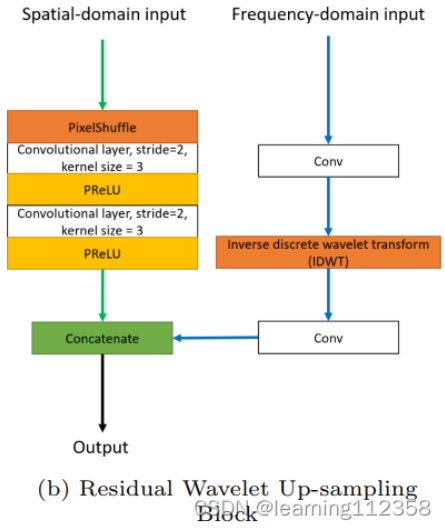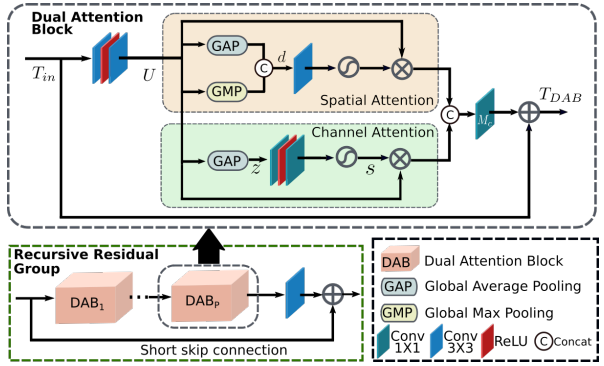深度学习模块最小构成部分
1.PixelShuffle
nn.PixelShuffle(upscale_factor=scailingFactor)
2.Convolution
3.Strided Convolution
深度学习经典模块
Beyond Joint Demosaicking and Denoising: An Image Processing Pipeline for a Pixel-bin Image Sensor
1.Group Depth Attention Bottleneck Block

2.Depth A ttention Bottleneck Block

3.Spatial Attention Block

class SpatialAttention(nn.Module):
def __init__(self, kernel_size=7):
super(SpatialAttention, self).__init__()
assert kernel_size in (3, 7), 'kernel size must be 3 or 7'
padding = 3 if kernel_size == 7 else 1
self.conv1 = nn.Conv2d(2, 1, kernel_size, padding=padding, bias=False)
self.sigmoid = nn.Sigmoid()
def forward(self, x):
avg_out = torch.mean(x, dim=1, keepdim=True)
max_out, _ = torch.max(x, dim=1, keepdim=True)
x = torch.cat([avg_out, max_out], dim=1)
x = self.conv1(x)
return self.sigmoid(x)
class SpatialAttentionBlock(nn.Module):
def __init__(self, spatial_filter=32):
super(SpatialAttentionBlock, self).__init__()
self.spatialAttenton = SpatialAttention()
self.conv = nn.Conv2d(spatial_filter, spatial_filter, 3, padding=1)
def forward(self, x):
x1 = self.spatialAttenton(x)
#print(" spatial attention",x1.shape)
xC = self.conv(x)
#print("conv",xC.shape)
y = x1 * xC
#print("output",y.shape)
return y
AWNet: Attentive Wavelet Network for Image ISP AWNet
1.全局上下文 res-dense 模块
全局上下文 res-dense 模块包含一个残差密集块 (RDB) 和一个全局上下文块 (GCB)

1.1 残差密集块 (RDB)
class MakeDense(nn.Module):
'''单个残差块'''
def __init__(self, in_channels, growth_rate, kernel_size=3):
super(MakeDense, self).__init__()
self.conv = nn.Conv2d(in_channels, growth_rate, kernel_size=kernel_size, padding=(kernel_size - 1) // 2)
self.norm_layer = nn.BatchNorm2d(growth_rate)
def forward(self, x):
out = F.relu(self.conv(x))
out = self.norm_layer(out)
out = torch.cat((x, out), 1)
return out
for i in range(num_dense_layer):
'''循环连接单个残差块形成一个残差密集块 (RDB) '''
modules.append(MakeDense(_in_channels, growth_rate))
_in_channels += growth_rate
self.residual_dense_layers = nn.Sequential(*modules)
1.2 全局上下文块 (GCB)
class ContextBlock2d(nn.Module):
def __init__(self, inplanes=9, planes=32, pool='att', fusions=['channel_add'], ratio=4):
super(ContextBlock2d, self).__init__()
assert pool in ['avg', 'att']
assert all([f in ['channel_add', 'channel_mul'] for f in fusions])
assert len(fusions) > 0, 'at least one fusion should be used'
self.inplanes = inplanes
self.planes = planes
self.pool = pool
self.fusions = fusions
if 'att' in pool:
self.conv_mask = nn.Conv2d(inplanes, 1, kernel_size=1) # context Modeling
self.softmax = nn.Softmax(dim=2)
else:
self.avg_pool = nn.AdaptiveAvgPool2d(1)
if 'channel_add' in fusions:
self.channel_add_conv = nn.Sequential(
nn.Conv2d(self.inplanes, self.planes // ratio, kernel_size=1),
nn.LayerNorm([self.planes // ratio, 1, 1]),
nn.PReLU(),
nn.Conv2d(self.planes // ratio, self.inplanes, kernel_size=1)
)
else:
self.channel_add_conv = None
if 'channel_mul' in fusions:
self.channel_mul_conv = nn.Sequential(
nn.Conv2d(self.inplanes, self.planes // ratio, kernel_size=1),
nn.LayerNorm([self.planes // ratio, 1, 1]),
nn.PReLU(),
nn.Conv2d(self.planes // ratio, self.inplanes, kernel_size=1)
)
else:
self.channel_mul_conv = None
def spatial_pool(self, x):
batch, channel, height, width = x.size()
if self.pool == 'att':
input_x = x
# [N, C, H * W]
input_x = input_x.view(batch, channel, height * width)
# [N, 1, C, H * W]
input_x = input_x.unsqueeze(1)
# [N, 1, H, W]
context_mask = self.conv_mask(x)
# [N, 1, H * W]
context_mask = context_mask.view(batch, 1, height * width)
# [N, 1, H * W]
context_mask = self.softmax(context_mask)
# [N, 1, H * W, 1]
context_mask = context_mask.unsqueeze(3)
# [N, 1, C, 1]
context = torch.matmul(input_x, context_mask)
# [N, C, 1, 1]
context = context.view(batch, channel, 1, 1)
else:
# [N, C, 1, 1]
context = self.avg_pool(x)
return context
def forward(self, x):
# [N, C, 1, 1]
context = self.spatial_pool(x)
if self.channel_mul_conv is not None:
# [N, C, 1, 1]
channel_mul_term = torch.sigmoid(self.channel_mul_conv(context))
out = x * channel_mul_term
else:
out = x
if self.channel_add_conv is not None:
# [N, C, 1, 1]
channel_add_term = self.channel_add_conv(context)
out = out + channel_add_term
return out
2.离散小波变换(DWT)
2.1离散小波变换
DWT 的本质是将输入特征图分解为高频和低频分量,离散小波变换(DWT)上采样和下采样
def dwt_init(x):
x01 = x[:, :, 0::2, :] / 2
x02 = x[:, :, 1::2, :] / 2
x1 = x01[:, :, :, 0::2]
x2 = x02[:, :, :, 0::2]
x3 = x01[:, :, :, 1::2]
x4 = x02[:, :, :, 1::2]
x_LL = x1 + x2 + x3 + x4
x_HL = -x1 - x2 + x3 + x4
x_LH = -x1 + x2 - x3 + x4
x_HH = x1 - x2 - x3 + x4
return x_LL, torch.cat((x_LL, x_HL, x_LH, x_HH), 1)
class DWT(nn.Module):
def __init__(self):
super(DWT, self).__init__()
self.requires_grad = False
def forward(self, x):
return dwt_init(x)
2.1离散小波逆变换 Inverse discrete wavelet transform (IDWT)
def iwt_init(x):
r = 2
in_batch, in_channel, in_height, in_width = x.size()
out_batch, out_channel, out_height, out_width = in_batch, int(
in_channel / (r**2)), r * in_height, r * in_width
x1 = x[:, 0:out_channel, :, :] / 2
x2 = x[:, out_channel:out_channel * 2, :, :] / 2
x3 = x[:, out_channel * 2:out_channel * 3, :, :] / 2
x4 = x[:, out_channel * 3:out_channel * 4, :, :] / 2
h = torch.zeros([out_batch, out_channel, out_height, out_width]).float().to(x.device)
h[:, :, 0::2, 0::2] = x1 - x2 - x3 + x4
h[:, :, 1::2, 0::2] = x1 - x2 + x3 - x4
h[:, :, 0::2, 1::2] = x1 + x2 - x3 - x4
h[:, :, 1::2, 1::2] = x1 + x2 + x3 + x4
return h
class IWT(nn.Module):
def __init__(self):
super(IWT, self).__init__()
self.requires_grad = False
def forward(self, x):
return iwt_init(x)
2.2Residual Wavelet Down-sampling Block

class GCWTResDown(nn.Module):
def __init__(self, in_channels, att_block, norm_layer=nn.BatchNorm2d):
super().__init__()
self.dwt = DWT()
if norm_layer:
self.stem = nn.Sequential(nn.Conv2d(in_channels, in_channels, kernel_size=3, stride=2, padding=1),
norm_layer(in_channels),
nn.PReLU(),
nn.Conv2d(in_channels, in_channels, kernel_size=3, stride=1, padding=1),
norm_layer(in_channels),
nn.PReLU())
else:
self.stem = nn.Sequential(nn.Conv2d(in_channels, in_channels, kernel_size=3, stride=2, padding=1),
nn.PReLU(),
nn.Conv2d(in_channels, in_channels, kernel_size=3, stride=1, padding=1),
nn.PReLU())
self.conv1x1 = nn.Conv2d(in_channels, in_channels, kernel_size=1, padding=0)
self.conv_down = nn.Conv2d(in_channels, in_channels, kernel_size=3, padding=1, stride=2)
#self.att = att_block(in_channels * 2, in_channels * 2)
def forward(self, x):
stem = self.stem(x)
xLL, dwt = self.dwt(x)
res = self.conv1x1(xLL)
out = torch.cat([stem, res], dim=1)
#out = self.att(out)
return out, dwt
2.3 Residual Wavelet Up sampling Block

class GCIWTResUp(nn.Module):
def __init__(self, in_channels, att_block, norm_layer=None):
super().__init__()
if norm_layer:
self.stem = nn.Sequential(
nn.PixelShuffle(2),
nn.Conv2d(in_channels // 4, in_channels // 4, kernel_size=3, padding=1),
norm_layer(in_channels // 4),
nn.PReLU(),
nn.Conv2d(in_channels // 4, in_channels // 4, kernel_size=3, padding=1),
norm_layer(in_channels // 4),
nn.PReLU(),
)
else:
self.stem = nn.Sequential(
nn.PixelShuffle(2),
nn.Conv2d(in_channels // 4, in_channels // 4, kernel_size=3, padding=1),
nn.PReLU(),
nn.Conv2d(in_channels // 4, in_channels // 4, kernel_size=3, padding=1),
nn.PReLU(),
)
self.pre_conv_stem = nn.Conv2d(in_channels // 2, in_channels, kernel_size=1, padding=0)
self.pre_conv = nn.Conv2d(in_channels, in_channels, kernel_size=1, padding=0)
# self.prelu = nn.PReLU()
self.post_conv = nn.Conv2d(in_channels // 4, in_channels // 4, kernel_size=1, padding=0)
self.iwt = IWT()
self.last_conv = nn.Conv2d(in_channels // 2, in_channels // 4, kernel_size=1, padding=0)
# self.se = SE_net(in_channels // 2, in_channels // 4)
def forward(self, x, x_dwt):
x = self.pre_conv_stem(x)
stem = self.stem(x)
x_dwt = self.pre_conv(x_dwt)
x_iwt = self.iwt(x_dwt)
x_iwt = self.post_conv(x_iwt)
out = torch.cat((stem, x_iwt), dim=1)
out = self.last_conv(out)
return out
CycleISP: Real Image Restoration via Improved Data Synthesis
3.RRG: Recursive Residual Group

递归残差组 (RRG) 包含多个双重注意块 (DAB)。每个 DAB 包含空间注意和通道注意模块.
3.1Channel attention
class CALayer(nn.Module):
def __init__(self, channel, reduction=16):
super(CALayer, self).__init__()
# global average pooling: feature --> point
self.avg_pool = nn.AdaptiveAvgPool2d(1)
# feature channel downscale and upscale --> channel weight
self.conv_du = nn.Sequential(
nn.Conv2d(channel, channel // reduction, 1, padding=0, bias=True),
nn.ReLU(inplace=True),
nn.Conv2d(channel // reduction, channel, 1, padding=0, bias=True),
nn.Sigmoid()
)
def forward(self, x):
y = self.avg_pool(x)
y = self.conv_du(y)
return x * y
3.2Spatial attention
class BasicConv(nn.Module):
def __init__(self, in_planes, out_planes, kernel_size, stride=1, padding=0, dilation=1, groups=1, relu=True, bn=False, bias=False):
super(BasicConv, self).__init__()
self.out_channels = out_planes
self.conv = nn.Conv2d(in_planes, out_planes, kernel_size=kernel_size, stride=stride, padding=padding, dilation=dilation, groups=groups, bias=bias)
self.bn = nn.BatchNorm2d(out_planes,eps=1e-5, momentum=0.01, affine=True) if bn else None
self.relu = nn.ReLU() if relu else None
def forward(self, x):
x = self.conv(x)
if self.bn is not None:
x = self.bn(x)
if self.relu is not None:
x = self.relu(x)
return x
class ChannelPool(nn.Module):
def forward(self, x):
return torch.cat( (torch.max(x,1)[0].unsqueeze(1), torch.mean(x,1).unsqueeze(1)), dim=1 )
class spatial_attn_layer(nn.Module):
def __init__(self, kernel_size=3):
super(spatial_attn_layer, self).__init__()
self.compress = ChannelPool()
self.spatial = BasicConv(2, 1, kernel_size, stride=1, padding=(kernel_size-1) // 2, relu=False)
def forward(self, x):
# import pdb;pdb.set_trace()
x_compress = self.compress(x)
x_out = self.spatial(x_compress)
scale = torch.sigmoid(x_out) # broadcasting
return x * scale
3.3双重注意块(DAB)
class DAB(nn.Module):
def __init__(
self, conv, n_feat, kernel_size, reduction,
bias=True, bn=False, act=nn.ReLU(True)):
super(DAB, self).__init__()
modules_body = []
for i in range(2):
modules_body.append(conv(n_feat, n_feat, kernel_size, bias=bias))
if bn: modules_body.append(nn.BatchNorm2d(n_feat))
if i == 0: modules_body.append(act)
self.SA = spatial_attn_layer() ## Spatial Attention
self.CA = CALayer(n_feat, reduction) ## Channel Attention
self.body = nn.Sequential(*modules_body)
self.conv1x1 = nn.Conv2d(n_feat*2, n_feat, kernel_size=1)
def forward(self, x):
res = self.body(x)
sa_branch = self.SA(res)
ca_branch = self.CA(res)
res = torch.cat([sa_branch, ca_branch], dim=1)
res = self.conv1x1(res)
res += x
return res
3.4 Recursive Residual Group
class RRG(nn.Module):
def __init__(self, conv, n_feat, kernel_size, reduction, act, num_dab):
super(RRG, self).__init__()
modules_body = []
modules_body = [
DAB(
conv, n_feat, kernel_size, reduction, bias=True, bn=False, act=act) \
for _ in range(num_dab)]
modules_body.append(conv(n_feat, n_feat, kernel_size))
self.body = nn.Sequential(*modules_body)
def forward(self, x):
res = self.body(x)
res += x
return res
3.5 Color Correction
class CCM(nn.Module):
def __init__(self, conv=conv):
super(CCM, self).__init__()
input_nc = 3
output_nc = 96
num_rrg = 2
num_dab = 2
n_feats = 96
kernel_size = 3
reduction = 8
sigma = 12 ## GAUSSIAN_SIGMA
act =nn.PReLU(n_feats)
modules_head = [conv(input_nc, n_feats, kernel_size = kernel_size, stride = 1)]
modules_downsample = [nn.MaxPool2d(kernel_size=2)]
self.downsample = nn.Sequential(*modules_downsample)
modules_body = [
RRG(
conv, n_feats, kernel_size, reduction, act=act, num_dab=num_dab) \
for _ in range(num_rrg)]
modules_body.append(conv(n_feats, n_feats, kernel_size))
modules_body.append(act)
modules_tail = [conv(n_feats, output_nc, kernel_size),nn.Sigmoid()]
self.head = nn.Sequential(*modules_head)
self.body = nn.Sequential(*modules_body)
self.tail = nn.Sequential(*modules_tail)
self.blur, self.pad = get_gaussian_kernel(sigma=sigma)
def forward(self, x):
x = F.pad(x, (self.pad, self.pad, self.pad, self.pad), mode='reflect')
x = self.blur(x)
x = self.head(x)
x = self.downsample(x)
x = self.body(x)
x = self.tail(x)
return x
























 1557
1557











 被折叠的 条评论
为什么被折叠?
被折叠的 条评论
为什么被折叠?








